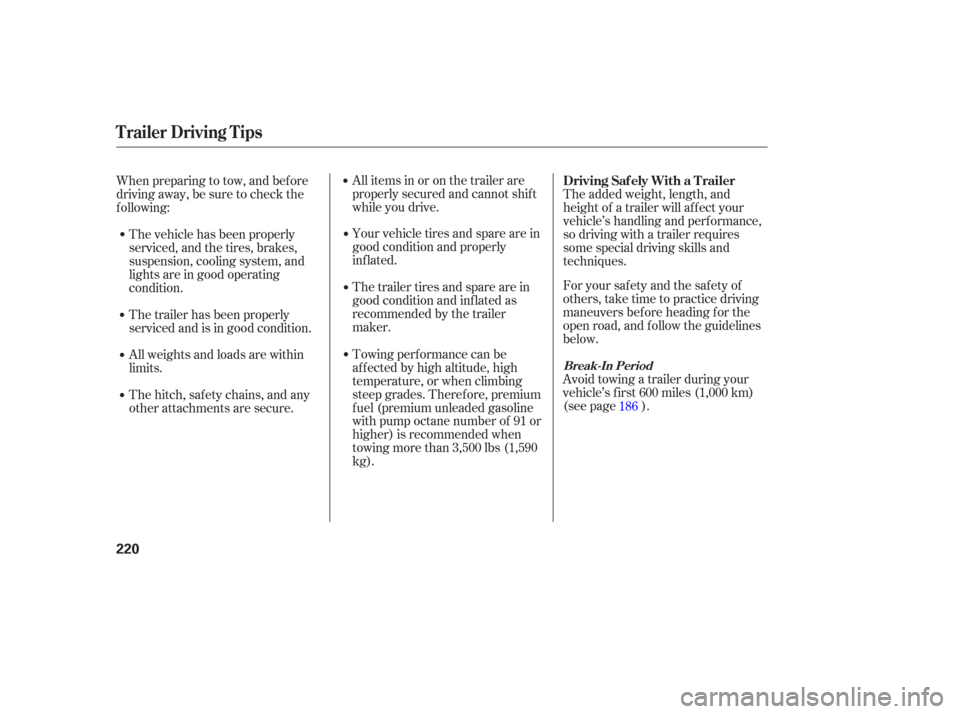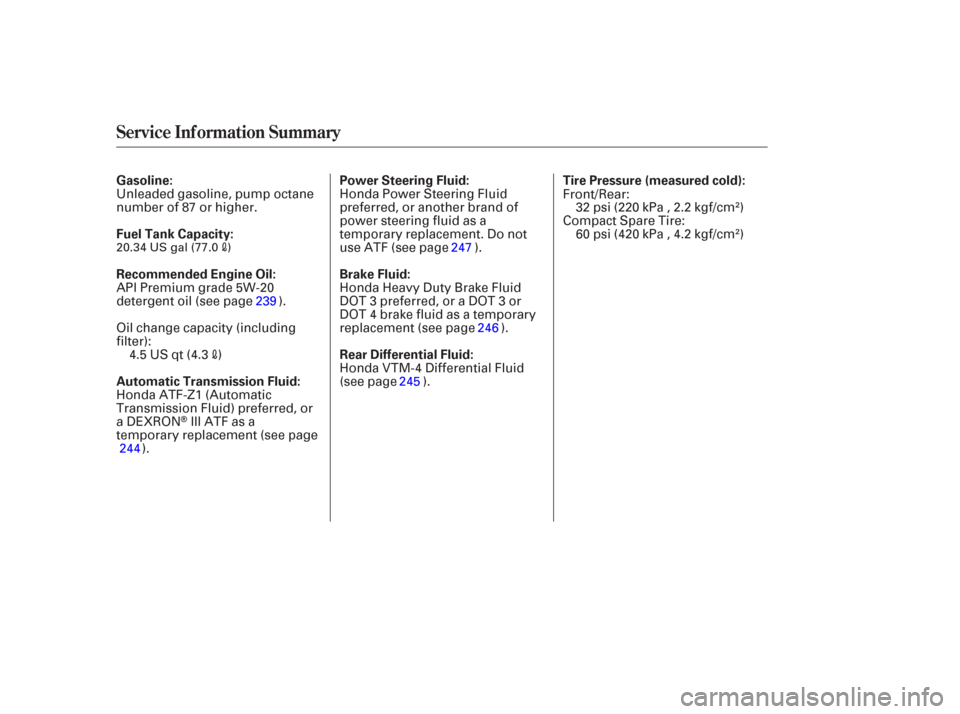2006 HONDA PILOT octane
[x] Cancel search: octanePage 188 of 316

Help assure your vehicle’s f uture
reliability and perf ormance by paying
extra attention to how you drive
during the f irst 600 miles (1,000 km).
During this period:Avoid full-throttle starts and rapid
acceleration.
Do not change the oil until the
scheduled maintenance time.
Avoidhardbrakingforthefirst
200 miles (300 km).
Do not tow a trailer.
You should also f ollow these
recommendations with an
overhauled or exchanged engine, or
when the brakes are replaced. In addition, in order to maintain good
perf ormance, f uel economy, and
emissions control, we strongly
recommend, in areas where it is
available, the use of gasoline that
does NOT contain manganese-based
f uel additives such as MMT. Your vehicle is designed to operate
on unleaded gasoline with a pump
octane number of 87 or higher. Use
of a lower octane gasoline can cause
a persistent, heavy metallic rapping
noise that can lead to engine damage.
We recommend using quality
gasolines containing detergent
additives that help prevent fuel
system and engine deposits.
Use of gasoline with these additives
may adversely af f ect perf ormance,
and cause the malfunction indicator
lamp on your instrument panel to
come on. If this happens, contact
your dealer f or service.Some gasoline today is blended with
oxygenates such as ethanol or
MTBE. Your vehicle is designed to
operate on oxygenated gasoline
containing up to 10 percent ethanol
by volume and up to 15 percent
MTBE by volume. Do not use
gasoline containing methanol.
If you notice any undesirable
operating symptoms, try another
service station or switch to another
brand of gasoline.
Premium f uel is recommended when
towing in certain conditions (see
page ).
For f urther important f uel-related
inf ormation, please ref er to your
.
220
Break-in Period, Fuel Recommendation
Break-in Period
Fuel Recommendation
Quick Start Guide
186
Page 222 of 316

Your vehicle tires and spare are in
good condition and properly
inf lated.
The trailer tires and spare are in
good condition and inf lated as
recommended by the trailer
maker.Foryoursafetyandthesafetyof
others, take time to practice driving
maneuvers bef ore heading f or the
open road, and f ollow the guidelines
below.
Avoid towing a trailer during your
vehicle’s f irst 600 miles (1,000 km)
(see page ).
When preparing to tow, and bef ore
driving away, be sure to check the
f ollowing:
The vehicle has been properly
serviced, and the tires, brakes,
suspension, cooling system, and
lights are in good operating
condition.
The trailer has been properly
serviced and is in good condition.
All weights and loads are within
limits.
Thehitch,safetychains,andany
other attachments are secure. All items in or on the trailer are
properly secured and cannot shif t
while you drive.
Towing perf ormance can be
af f ected by high altitude, high
temperature, or when climbing
steep grades. Theref ore, premium
f uel (premium unleaded gasoline
with pump octane number of 91 or
higher) is recommended when
towing more than 3,500 lbs (1,590
kg). The added weight, length, and
height of a trailer will af f ect your
vehicle’s handling and perf ormance,
so driving with a trailer requires
some special driving skills and
techniques.
186
Trailer Driving Tips
Break-In Period
Driving Saf ely With a T railer
220
Page 309 of 316

CONT INUED
Engine....
Coolant Temperature Gauge . 71
Malf unction Indicator ................................
Lamp .62, 277
........
Oil Pressure Indicator . 62,276
..............
Oil, What Kind to Use . 239
...............................
Overheating .274
............................
Specif ications .289
............................
Speed Limiter .202
.......................................
Starting .199
.
Evaporative Emissions Controls . 293
...............................
Exhaust Fumes .57
Exhaust Gas Recirculation ........................................
System .294
Expectant Mothers, Use of Seat ........................................
Belts by .19
...............
Gas Mileage, Improving . 190
.........................................
Gasoline .186
...............
Fuel Reserve Indicator . 67
...........................................
Gauge .70
................
Octane Requirement . 186
........................
Tank, Filling the .187
................
Gas Station Procedures . 187Gauges
...
Engine Coolant Temperature . 71
...............................................
Fuel .70
GAWR (Gross Axle Weight .......................................
Rating) .214
GCWR (Gross Combined Weight .......................................
Rating) .214
............
Gearshif t Lever Positions . 200
........................................
Glove Box .99
GVWR (Gross Vehicle Weight .......................................
Rating) .214
.............
Halogen Headlight Bulbs . 248
.................
Hazard Warning Button . 77
...................................
Fan, Interior .106
.........................................
Features .105
....................
Filling the Fuel Tank . 187
Filters ...............................................
Oil .240
.............
Flashers, Hazard Warning . 77
...................
Flat Tire, Changing a . 267Fluids
..........
Automatic Transmission . 244
..........................................
Brake .246
..........................
Power Steering .247
................
Windshield Washers . 243
...................
Folding the Third Seat . 89
..........................
Four-way Flashers .77
.................................................
Fuel .186
...............................
Cap Message .72
......................
Fill Door and Cap .187
...........................................
Gauge .70
................
Octane Requirement . 186
........................
Reserve Indicator .67
........................
Tank, Filling the .187
.....................
Fuses, Checking the .279
Index
F GH
INDEX
III
Page 311 of 316

CONT INUED
..................................
Maintenance .227
Owner’s Maintenance ...................................
Checks .234
.................................
Record .236-237
................................
Minder .229-235
.........................
Minder Indicator .69
..........................................
Saf ety .228
.
Malf unction Indicator Lamp . 62,277
..............
Manual Seat Adjustments . 88
...............................
Meters, Gauges .70
.................................
Modif ications .192
.........................................
Moonroof .96
.................................
Lower Anchor .47
...
Lubricant Specif ications Chart . 288
.........................................
Luggage .193
...................
Neutral Gear Position . 201
..................
New Vehicle Break-in . 186
...................
NOTICE, Explanation of . i
...............
Numbers, Identif ication . 286 ...
Octane Requirement, Gasoline . 186
.........................................
Odometer .70
...............................
Odometer, Trip .70
....................
Of f -Highway Driving . 223
...................
Of f -Road Precautions . 223
Oil ........................
Change, How to .240
......................
Change, When to .229
......................
Checking Engine .189
..............
Pressure Indicator . 62,276
Selecting Proper Viscosity ......................................
Chart .239
...........
ON (Ignition Key Position) . 81
Onboard Ref ueling Vapor ....................................
Recovery .293
..............................
Outside Mirrors .93
....................
Overheating, Engine .274
....
Owner’s Maintenance Checks . 234
..............
Panel Brightness Control . 76
........................
Park Gear Position .201
...........................................
Parking .207 .................................
Parking Brake .97
Parking Brake and Brake System ...............................
Indicator .63, 278
.................................
Parking Lights .75
..
Parking Over Things that Burn . 295
..........................
Playing the Radio .117
................................
Playing a Disc .130
....
Playing the Disc Changer . 131,134
.............................
PGM-FI System .294
................
Power Seat Adjustments . 87
.................
Power Socket Locations . 98
..............................
Power Windows .94
.........
Pregnancy, Using Seat Belts . 19
.........
Protecting Adults and Teens . 12
...
Additional Safety Precautions . 20
.....
Advice f or Pregnant Women . 19
........................
Protecting Children .38
...........................
Protecting Inf ants .43
...........
Protecting Larger Children . 53
.............
Protecting Small Children . 44
Index
INDEXP
M
N O
V
Page 316 of 316

Service Inf ormation Summary
Gasoline:
Fuel Tank Capacity:
Recommended Engine Oil:Power Steering Fluid:
Rear Differential Fluid: Brake Fluid:Tire Pressure (measured cold):
Automatic Transmission Fluid: 32 psi (220 kPa , 2.2 kgf/cm
)
60 psi (420 kPa , 4.2 kgf/cm
)
Honda Power Steering Fluid
preferred, or another brand of
power steering fluid as a
temporary replacement. Do not
use ATF (see page ).
Honda Heavy Duty Brake Fluid
DOT 3 preferred, or a DOT 3 or
DOT 4 brake fluid as a temporary
replacement (see page ). Compact Spare Tire: Front/Rear:
Honda VTM-4 Differential Fluid
(see page ).
API Premium grade 5W-20
detergent oil (see page ).
Oil change capacity (including
filter):
4.5 US qt (4.3
)
Honda ATF-Z1 (Automatic
Transmission Fluid) preferred, or
aDEXRON
III ATF as a
temporary replacement (see page ).
Unleaded gasoline, pump octane
number of 87 or higher.
239
244 247
246
245
20.34 US gal (77.0)